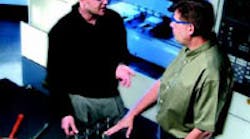IN SEARCHOF W A S T E Manufacturing isnt truly lean until waste is eliminated.
By Jamie Flinchbaugh, Lean Learning Center Edited by James J. Benes, associate editor
To rid processes of waste, shops must take the perspective of the customer, the product, and machine tool operator. Each provides an insight into potential productivity gains. Most shops are too busy getting work done, meeting goals and objectives, and initiating business strategies to look for waste. They should because eliminating waste is key to establishing a true lean-manufacturing operation. Lean-thinking shops dig below the surface to find the causes of waste and work to eliminate them. Its an ongoing process because waste continuously creeps back into organizations and their operations. Examining processes to decide if they can be improved by eliminating waste requires taking a nontraditional point of view. For instance, does a shop concentrate on results and
Mr. Flinchbaugh is cofounder and partner at Lean Learning Center, Novi, Mich.
COMMONWASTES
Shops
measures, or analyze the systems that drove that performance? The ability to recognize and understand the systems that create results is not a natural ability. However, lean thinkers view processes in these terms and analyze operations from the critical perspectives of the customer, the product, and the shop worker. A fundamental principle of lean thinking is viewing value through customers eyes and recognizing everything that does not add value is waste. Traditionally, shops may think that as long as customers receive the agreed-upon product, they are unaware of the process, but it certainly does affect them. Think about how customers see the process. How does it meet their needs? If a shop makes a particular tooling or scheduling change, how does it affect the customer? This customer perspective is the most important lens through which to view a process because, in a way, the customer pays the salaries of everyone in the shop. Unfortunately, time spent on valueadded activities usually represents less than 1% of a shops total manufacturing process. And most shops are so busy with this 1% they ignore the other 99+%, which is waste that has crept into the process. The solution is to start eliminating this waste to improve leadtimes, satisfy customers, and throw away less money. Examining a process from the products viewpoint is often overlooked because few shops take the time to physically follow a product from conception, through manufacturing, and finally through delivery. Although a customer may not care what happens to the product, the product is affected by the way it is processed and delivered. Experts suggest picking a steel blank and staying with it as it waits, moves into a machine tool and is rough cut, transfers to the finishing station, gets inspected, and moves again. Once shops realize the product and all the processes it goes through are paid for by the customer, they gain a different perspective from which to evaluate products and processes. When analyzing what the people involved in the process do, shops often mistakenly combine the views of what happens to the person and what happens to the part, but processes are far too complex to merge these two views. Shops must differentiate between product and person and understand the involvement of everyone in the process, even if this involvement is only for a second. Analyzing the movements of a machine operator shows how much non-value-added motion and activity make up this persons day. In doing so, the waste operators deal with and the nonproductive efforts they expend trying to eliminate it become apparent. can identify these seven wastes to help uncover opportunities for improvement.
Overproduction producing more than or sooner than is required by an enduser or in-process user.
Overprocessing doing more than is required and desired by the customer.
Motion - expending excess motion beyond value-added activities.
Defects not only part defects, but any defect in the process.
Transportation unnecessary movement of materials, particularly double and triple handling.
Inventory excess inventory is waste; the only good thing that can happen to inventory is to sell it.
Waiting waiting for information, people, tools, and materials.







